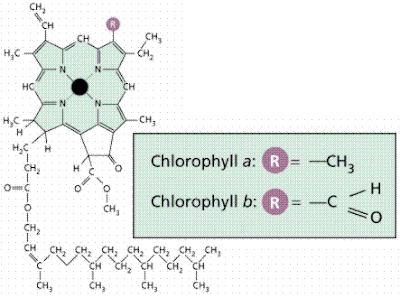#101 Photosynthetic Pigments
 Photosynthetic pigments are pigments presented in chloroplasts or photosynthetic bacteria. They capture light energy necessary for photosynthesis and convert it to chemical energy.
Photosynthetic pigments are pigments presented in chloroplasts or photosynthetic bacteria. They capture light energy necessary for photosynthesis and convert it to chemical energy. Pigments
- A pigment is any substance that absorbs light.
- The color of the pigment comes from the wavelengths of light that are reflected (not absorbed).
- If pigments absorb all wavelengths they will appear black.
- If pigments reflect most of the wavelengths they will appear white.
- The light absorption pattern of a pigment is called the absorption spectrum.
When pigments absorb light, electrons are temporarily boosted to a higher energy level. Energized electrons move further from the nucleus of the atom. When the e- returns to a lower energy level the energy may be:
- dissipated as heat
- re-emitted as a longer wavelength of light - fluorescence
- captured in a chemical bond (carbon gain!)
Photosynthetic pigments in chloroplast
Choloroplats contain several different pigments, which absorb different wavelengths of light. The photosynthetic pigments of higher plants form 2 groups: the cholophylls and the caroteinoids.
1. Chlorophylls absorb mainly red and blue-violet light, reflect green light - giving green leaves their colour.
2. Carotenoids: orange pigments that protect chlorophyll from damage by the formation of single oxygen atoms (free radicals). They can also absorb wavelengths of light that chlorophyll cannot absorb, and pass on some of the energy from the light to chlorophyll. They absorb strongly in the blue-violet range. Carotenoids are usually masked by the green chlorophylls.
There are 2 types of carotenoid:
There are 2 types of carotenoid:
- carotenes (β-carotene)
- xantophylls.
- Chlorophyll a is the most abundant pigment in most plants. Its absorption peaks are 430nm (blue) and 662nm (red). It emits an electron when it absorbs light.
- Chlorophyll b is similar to chlorophyll a, but its absorption peaks are 453nm and 642nm. It has a similar role to chlorophyll a, but is not as abundant.
- Carotenoids : carotene and Xanthophylls.
 |
| Chlorophill molecule. |
Absorption spectrum and action spectrum of chloroplast pigments
An absorption spectrum is a graph showing the percentage of light absorbed by pigments, for each wavelength of light.
An example is the absorption spectrum of chlorophyll a and b.
The action spectrum of photosynthesis is a graph showing the rate of photosynthesis for each wavelength of light. The rate of photosynthesis will not be the same for every wavelength of light.
The wavelengths that is does not absorb are reflected from it.
Chlorophyll Is the main pigment contained in chloroplasts. It looks green because it
reflects green light. Other wavelengths (colours) of light are absorbed.
llle diagram shows the wavelengths of light absorbed by the various pigments found
in chloroplasts. These graphs are called absorption spectra.
If we shine light of various wavelengths on chloroplasts containing different pigments, we can measure the rate at which they give off oxygen. These graphs are called action spectra.
An example is the absorption spectrum of chlorophyll a and b.
- The best absorption is seen with violet-blue light.
- There is also good absorption with red-orange light.
- Most of the green-yellow light is reflected and therefore not absorbed. This wavelength of light shows the least absorption.
The action spectrum of photosynthesis is a graph showing the rate of photosynthesis for each wavelength of light. The rate of photosynthesis will not be the same for every wavelength of light.
- The rate of photosynthesis is the least with green-yellow light (525 nm-625 nm).
- Red-orange light (625nm-700nm) shows a good rate of photosynthesis.
- The best rate of photosynthesis is seen with violet-blue light (400nm-525nm).
The wavelengths that is does not absorb are reflected from it.
Chlorophyll Is the main pigment contained in chloroplasts. It looks green because it
reflects green light. Other wavelengths (colours) of light are absorbed.
llle diagram shows the wavelengths of light absorbed by the various pigments found
in chloroplasts. These graphs are called absorption spectra.
If we shine light of various wavelengths on chloroplasts containing different pigments, we can measure the rate at which they give off oxygen. These graphs are called action spectra.
Syllabus: 13.1 Photosynthesis as an energy transfer process Light energy absorbed by chloroplast pigments in the light dependent stage of photosynthesis is used to drive reactions of the light independent stage that produce complex organic compounds. Chromatography is used to identify chloroplast pigments and was also used to identify the intermediates in the Calvin cycle. a) explain that energy transferred as ATP and reduced NADP from the light dependent stage is used during the light independent stage (Calvin cycle) of photosynthesis to produce complex organic molecules b) state the sites of the light dependent and the light independent stages in the chloroplast c) describe the role of chloroplast pigments (chlorophyll a, chlorophyll b, carotene and xanthophyll) in light absorption in the grana d) interpret absorption and action spectra of chloroplast pigments e) use chromatography to separate and identify chloroplast pigments and carry out an investigation to compare the chloroplast pigments in different plants (reference should be made to Rf values in identification) f) describe the light dependent stage as the photoactivation of chlorophyll resulting in the photolysis of water and the transfer of energy to ATP and reduced NADP (cyclic and non-cyclic photophosphorylation should be described in outline only) g) outline the three main stages of the Calvin cycle: • fixation of carbon dioxide by combination with ribulose bisphosphate (RuBP), a 5C compound, to yield two molecules of GP (PGA), a 3C compound • the reduction of GP to triose phosphate (TP) involving ATP and reduced NADP • the regeneration of ribulose bisphosphate (RuBP) using ATP h) describe, in outline, the conversion of Calvin cycle intermediates to carbohydrates, lipids and amino acids and their uses in the plant cell |








Comments
Post a Comment